The Effect of a Metal Particle on Surface Charge Accumulation Behavior of Epoxy Insulator with Zoning Coating
Abstract
:1. Introduction
2. Test Setup and Procedures
2.1. Test Insulator and Electrode Arrangement
2.2. Experimental Platform Arrangement
2.3. Preparation of Coatings with Different Conductivities
3. Results and Discussion
3.1. Behavior of the Charge Accumulation on the Insulator without Zoning Coating
3.2. Behaviors of the Charge Accumulation on the Insulator with Zoning Coating
3.3. Behaviors of the Charge Accumulation on the Insulator with Metal Particle
4. Inhibition Mechanism of Zoning Coating on Surface Charge Accumulation
5. Conclusions
Author Contributions
Funding
Conflicts of Interest
References
- Qi, B.; Zhang, G.; Li, C.; Gao, C.J.; Zhang, B.Y.; Chen, Z.Z. Research Status and Prospect of Gas-insulated Metal Enclosed Transmission Line. High Volt. Eng. 2015, 41, 1466–1473. [Google Scholar]
- Kumara, S.; Serdyuk, Y.; Gubanski, S. Simulation of Surface Charge Effect on Impulse Flashover Characteristics of Outdoor Polymeric Insulators. IEEE Trans. Dielec. Electr. Insul. 2010, 17, 1754–1763. [Google Scholar] [CrossRef]
- Hosokawa, M.; Endo, F.; Yamagiwa, T.; Ishokawa, T. Particle-Initiated Breakdown Characteristics and Reliability Improvement in SF6 Gas Insulation. IEEE Trans. Power Deliv. 1986, 1, 58–65. [Google Scholar] [CrossRef]
- Li, C.; Lin, C.; Zhang, B.; Li, Q.; Liu, W.; Hu, J.; He, J. Understanding Surface Charge Accumulation and Surface Flashover on Spacers in Compressed Gas Insulation. IEEE Trans. Dielec. Electr. Insul. 2018, 25, 1152–1166. [Google Scholar] [CrossRef]
- Ma, J.; Zhang, Q.; Wu, Z.; Guo, C.; Wen, T.; Wang, G.; Gao, C. Breakdown characteristics of particle-contaminated HVDC GIL under superimposed voltage of DC and impulse. IEEE Trans. Dielec. Electr. Insul. 2018, 25, 1439–1447. [Google Scholar] [CrossRef]
- Hara, M.; Maeda, Y.; Nakagawa, N.; Suehiro, J.; Yamada, S. DC breakdown voltage characteristics of saturated liquid helium in the presence of metallic particles. IEEE Trans. Dielectr. Electr. Insul. 2006, 13, 470–476. [Google Scholar] [CrossRef]
- Gao, Y.; Wang, H.; Yuan, X.; Zhao, H.; Li, Z. Surface Charge Accumulation on a Real Size Epoxy Insulator With Bouncing Metal Particle Under DC Voltage. IEEE Trans. Plasma Sci. 2021, 49, 2166–2175. [Google Scholar] [CrossRef]
- Wang, Z.; Wang, J.; Li, Q.; Liu, S. 3D Simulation and Experimental Study of Metal Particles’ Effect in DC GIL on Surface Charge Accumulation. Proc. CSEE 2016, 36, 6718–6726+6925. [Google Scholar]
- Li, B.; Wang, J.; Zhang, S. Influence of the DC-GIL Conductive Adherent Particles on the Charge Accumulation of Insulator Surface. High Volt. App. 2017, 53, 80–86. [Google Scholar]
- Cheng, H.; Wei, W.; Zhang, L.; Zou, L.; Zhao, T. Study on Linear Metal Particle Motion and Electrode-coating in DC GIL. In Proceedings of the 2021 International Conference on Advanced Electrical Equipment and Reliable Operation (AEERO), Beijing, China, 15–17 October 2021; pp. 1–4. [Google Scholar]
- Shao, T.; Liu, F.; Hai, B.; Ma, Y.; Wang, R.; Ren, C. Surface modification of epoxy using an atmospheric pressure dielectric barrier discharge to accelerate surface charge dissipation. IEEE Trans. Dielectr. Electr. Insul. 2017, 24, 1557–1565. [Google Scholar] [CrossRef]
- Qi, B.; Gao, C.; Lv, Y.; Li, C.; Tu, Y.; Xiong, J. The impact of nano-coating on surface charge accumulation of epoxy resin insulator: Characteristic and mechanism. J. Phys. D Appl. Phys. 2018, 51, 245303. [Google Scholar] [CrossRef]
- Gao, Y.; Yuan, X.; Wang, H.; Wang, M.; Li, Z.; Han, T. Graphene oxide addition with low fraction improving surface charge inhibition performance of epoxy/SiC coating under DC stress. IEEE Access 2020, 8, 11165–11173. [Google Scholar] [CrossRef]
- Xue, J.Y.; Chen, J.H.; Dong, J.H.; Wang, H.; Li, W.D.; Deng, J.B.; Zhang, G.J. The regulation mechanism of SiC/epoxy coatings on surface charge behavior and flashover performance of epoxy/alumina spacers. J. Phys. D Appl. Phys. 2019, 52, 405502. [Google Scholar] [CrossRef]
- Li, J.; Liang, H.C.; Du, B.X.; Wang, Z.H. Surface functional graded spacer for compact HVDC gaseous insulated system. IEEE Trans. Dielectr. Electr. Insul. 2019, 26, 664–667. [Google Scholar] [CrossRef]
- Gao, Y.; Li, Z.; Wang, H.; Yuan, X. Metal particle encouraged surface charge accumulation on epoxy insulator with multi-arc surface profile under DC voltage. IEEE Trans. Dielec. Electr. Insul. 2020, 27, 998–1006. [Google Scholar] [CrossRef]
- Gao, Y.; Wang, H.; Li, Z.; Yuan, X.; Zhao, H. Gaseous ionization dependence of surface charge pattern on epoxy insulator with complex surface profile under DC voltage. IEEE Trans. Dielec. Electr. Insul. 2021, 49, 1627–1635. [Google Scholar] [CrossRef]
- Zhang, B.; Zhang, G.; Wang, Q.; Li, C.; He, J.; An, Z. Suppression of surface charge accumulation on Al2O3-filled epoxy resin insulator under DC voltage by direct fluorination. AIP Adv. 2015, 5, 127207. [Google Scholar] [CrossRef] [Green Version]
- Kumada, A.; Okabe, S.; Hidaka, K. Residual charge distribution of positive surface streamer. J. Phys. D Appl. Phys. 2009, 42, 095209. [Google Scholar] [CrossRef]
- Li, C.; Fu, J.; Zi, Y.; Cao, Y. Insulator Surface Charge Behaviors: From Hazards to Functionality. IEEE Electr. Insul. Mag. 2022, 38, 6–14. [Google Scholar] [CrossRef]
- Winter, A.; Kindersberger, J. Transient Field Distribution in Gas-Solid Insulation Systems under DC Voltages. IEEE Trans. Dielec. Electr. Insul. 2014, 21, 116–128. [Google Scholar] [CrossRef]
- Kindersberger, J.; Lederle, C. Surface charge decay on insulators in air and sulfurhexafluorid—Part I: Simulation. IEEE Trans. Dielec. Electr. Insul. 2008, 15, 941–948. [Google Scholar] [CrossRef]
- Winter, A.; Kindersberger, J. Stationary Resistive Field Distribution along Epoxy Resin Insulators in Air under DC Voltage. IEEE Trans. Dielec. Electr. Insul. 2012, 19, 1732–1739. [Google Scholar] [CrossRef]
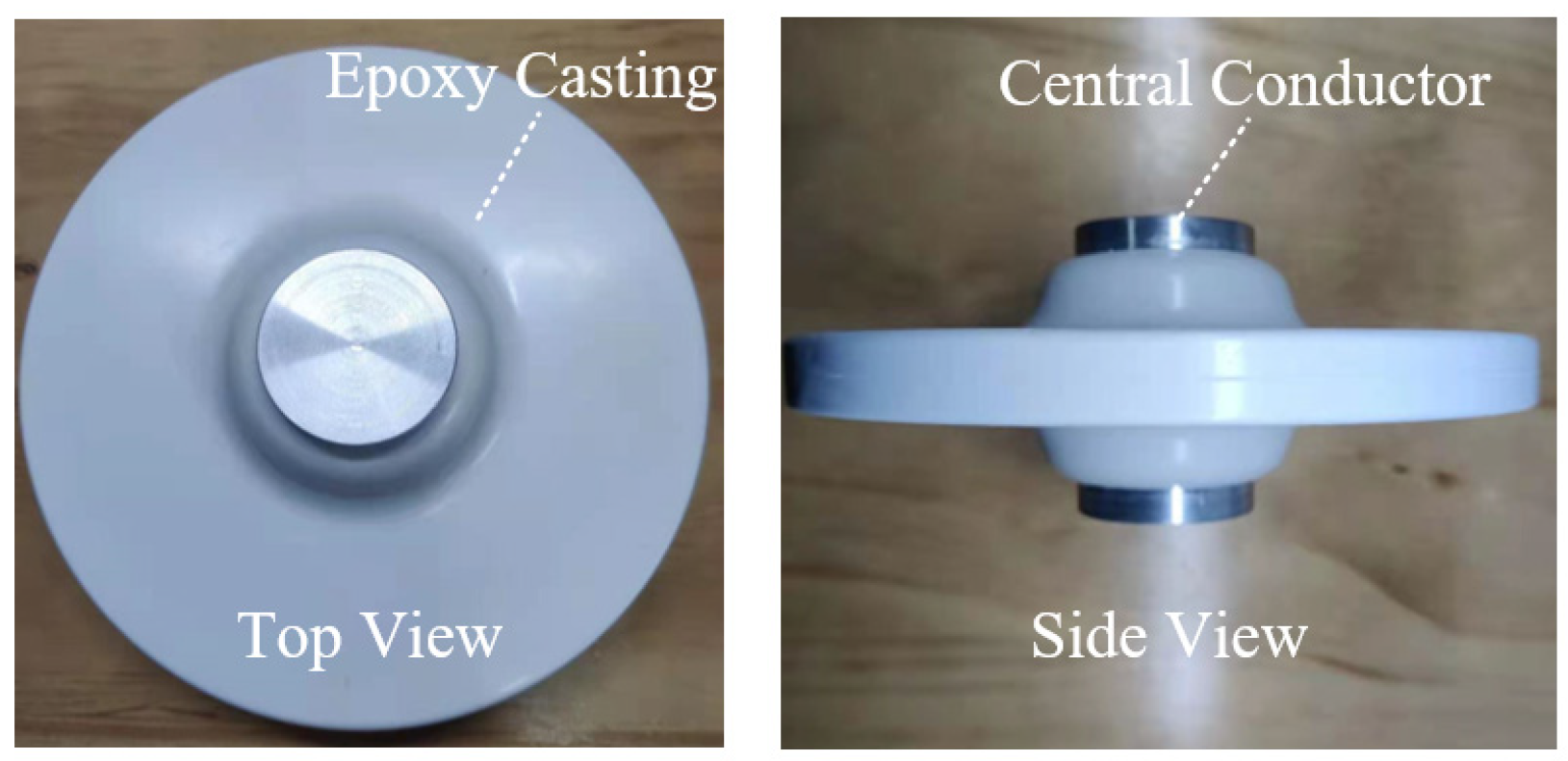
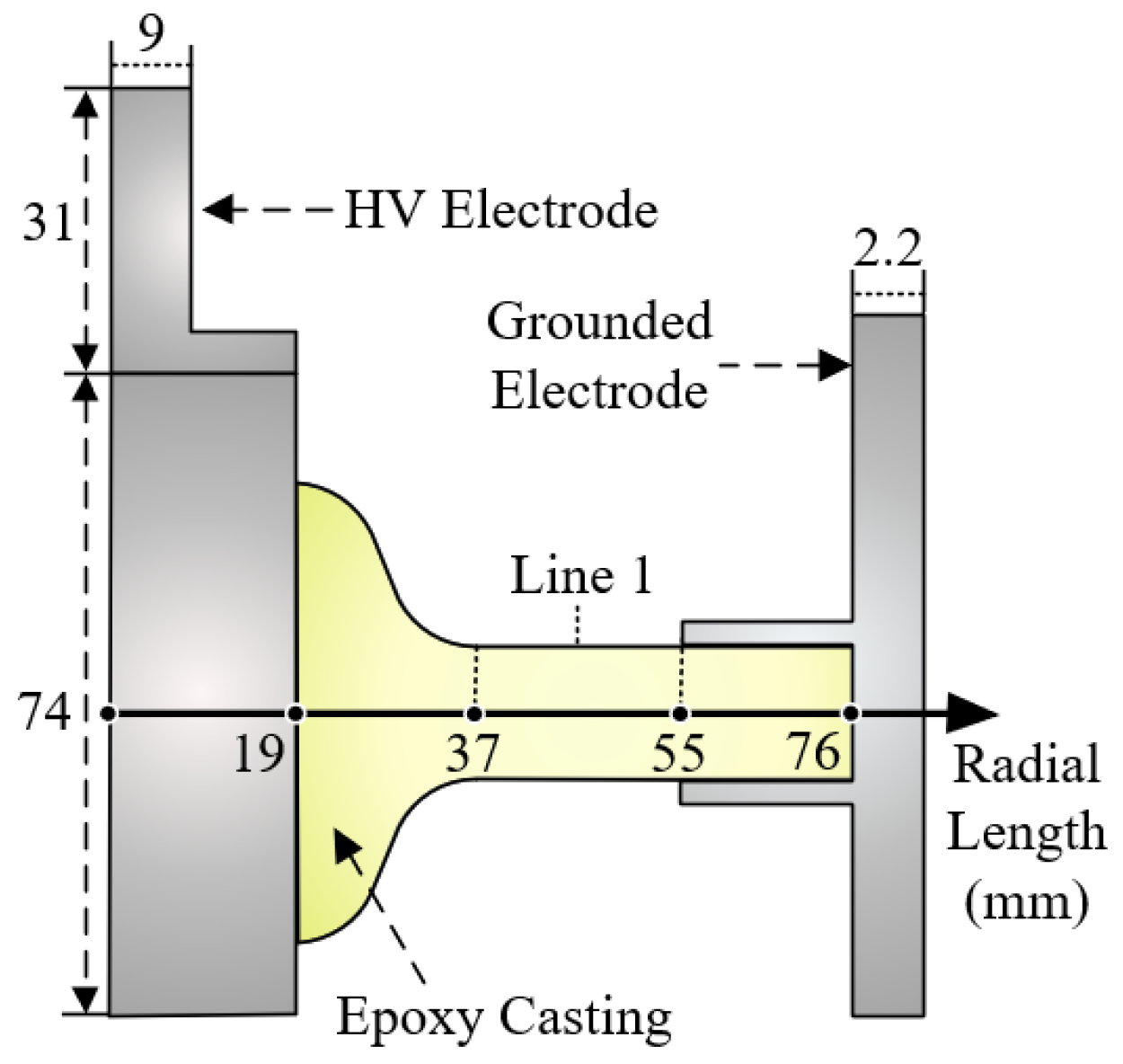
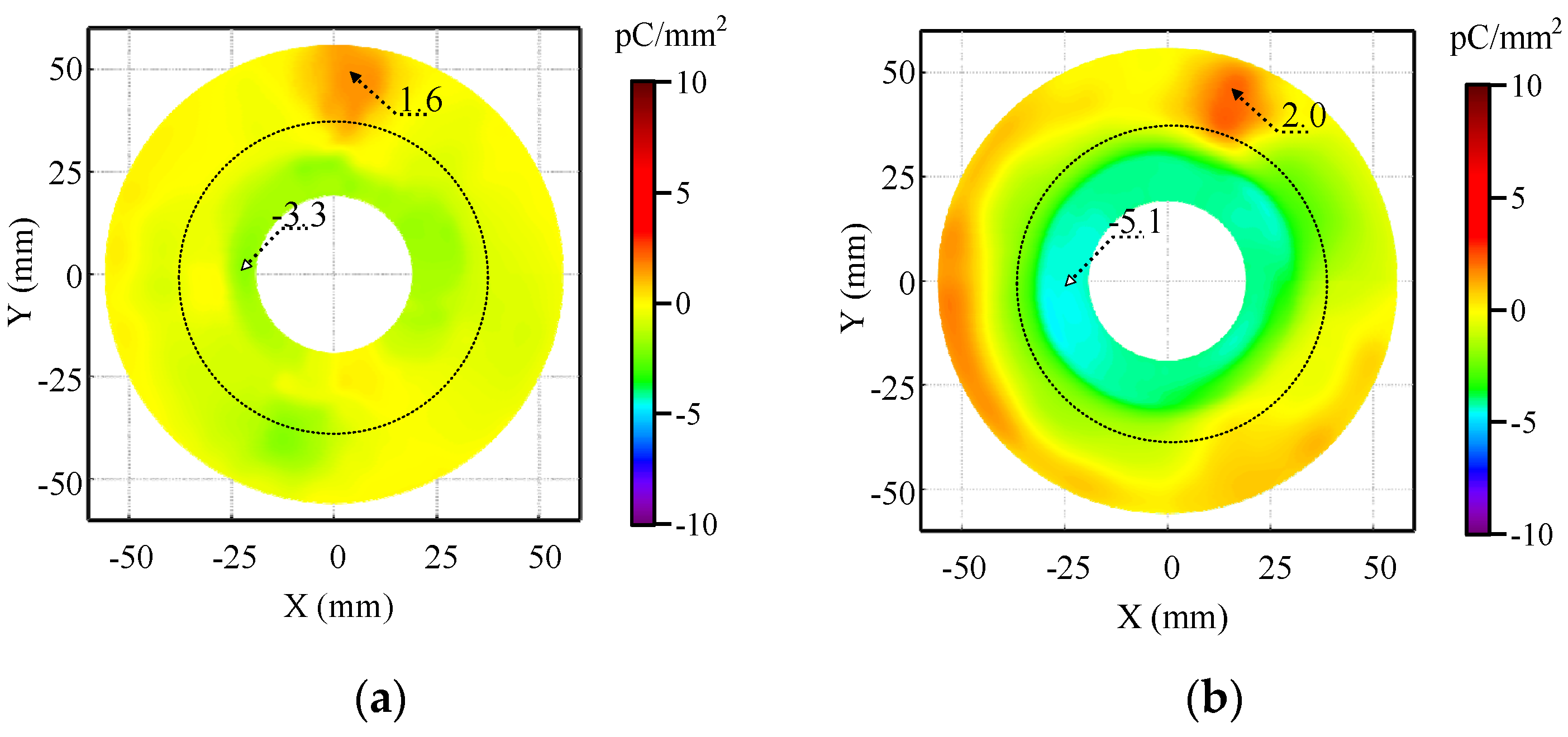
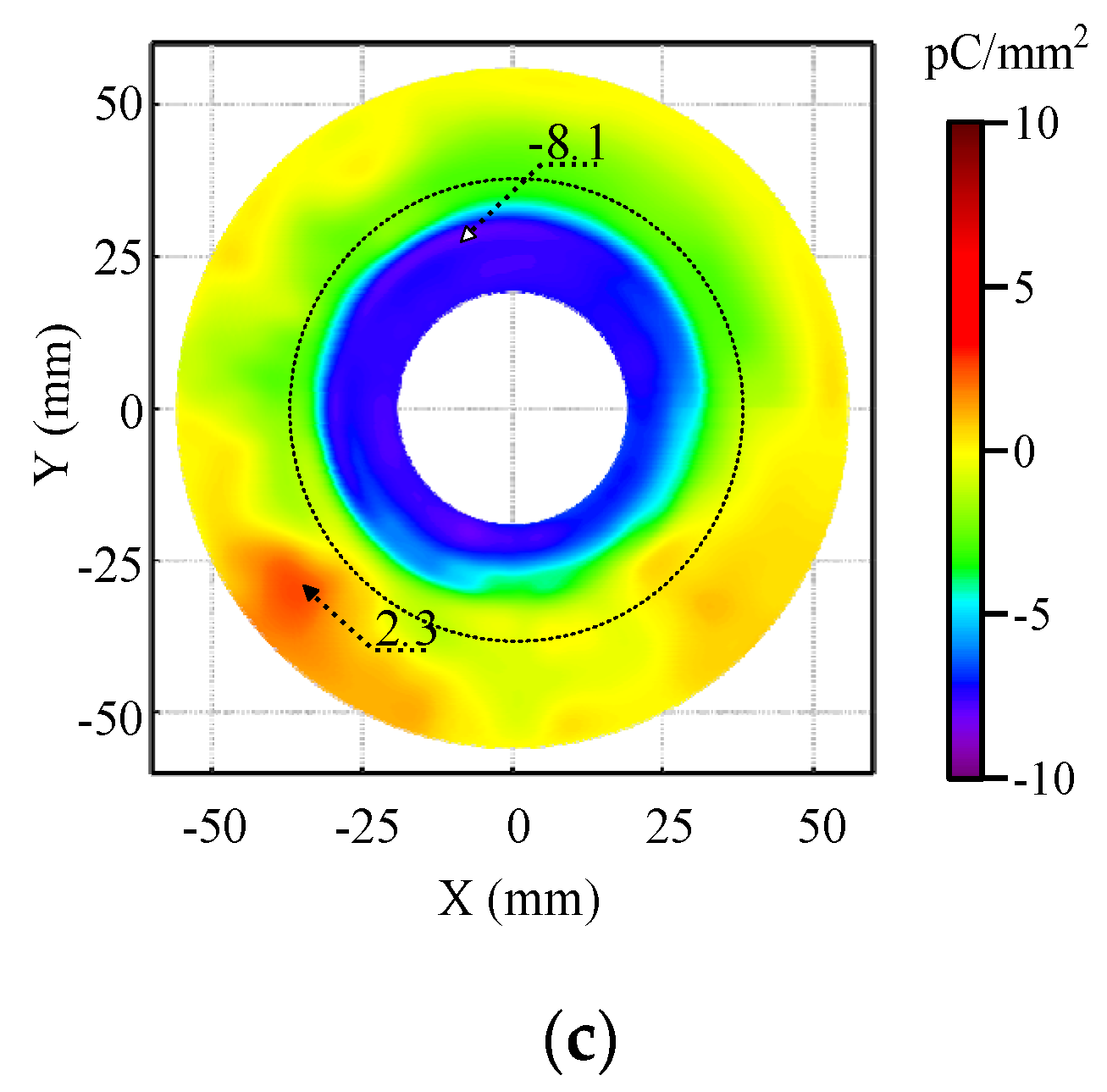
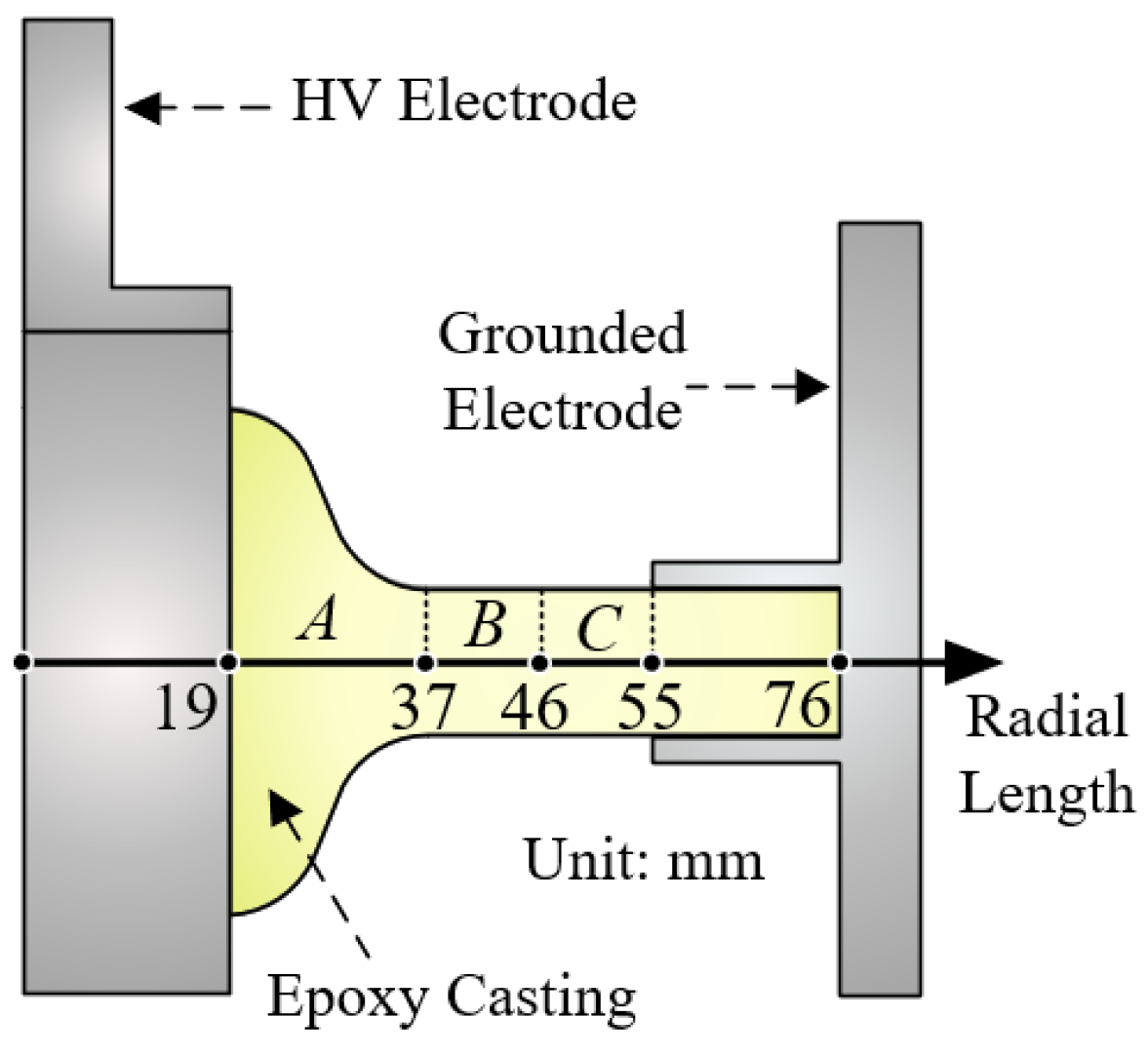
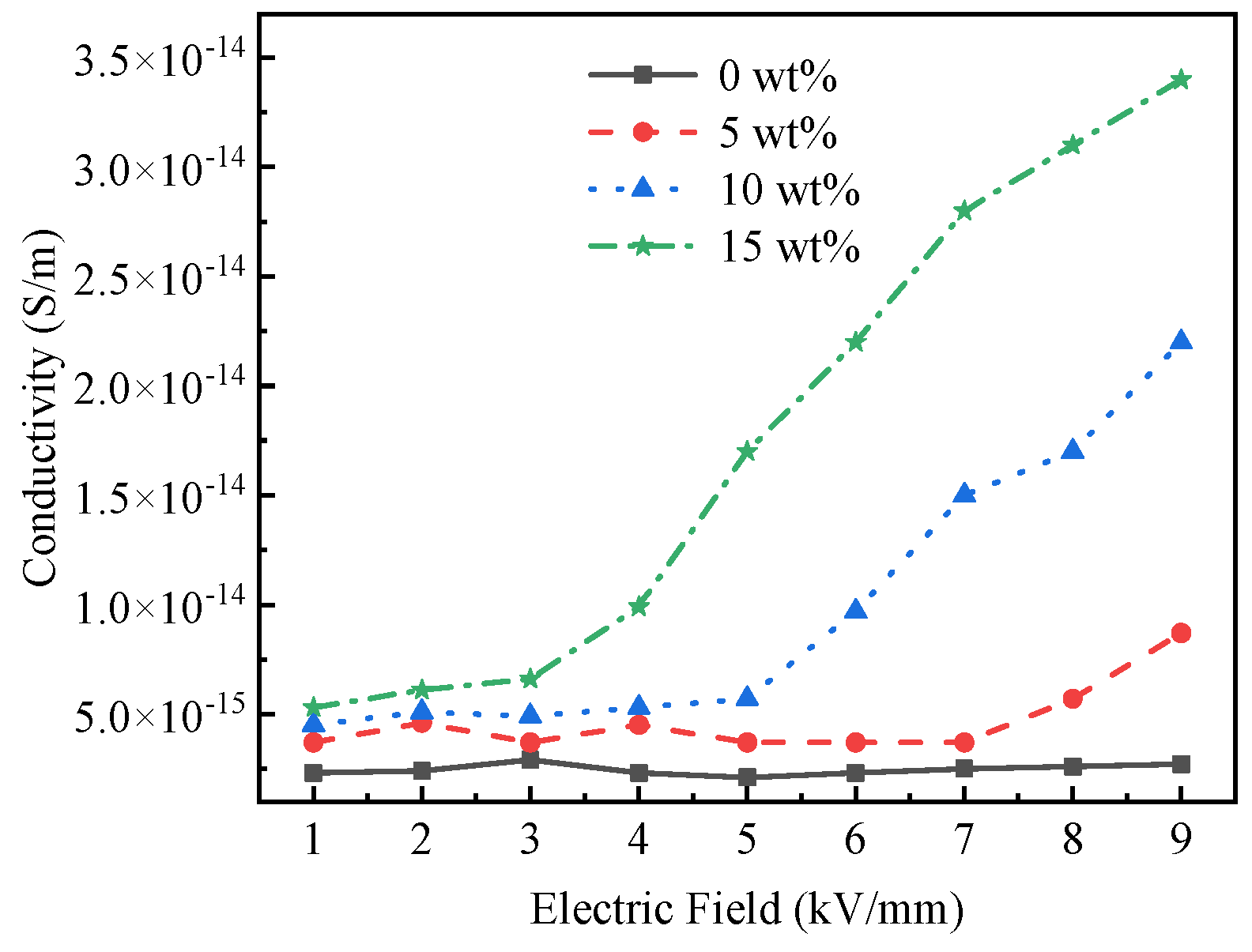
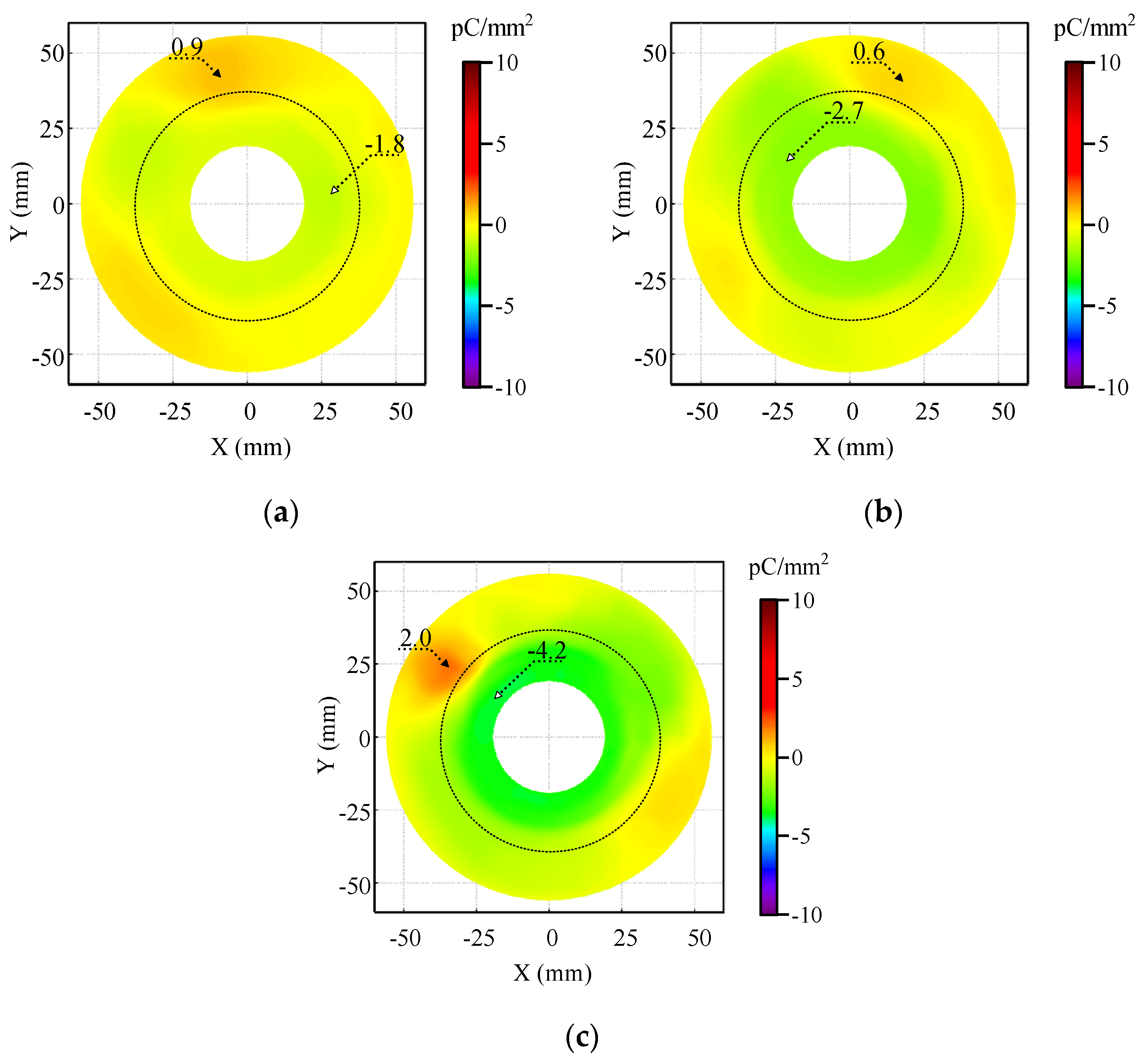

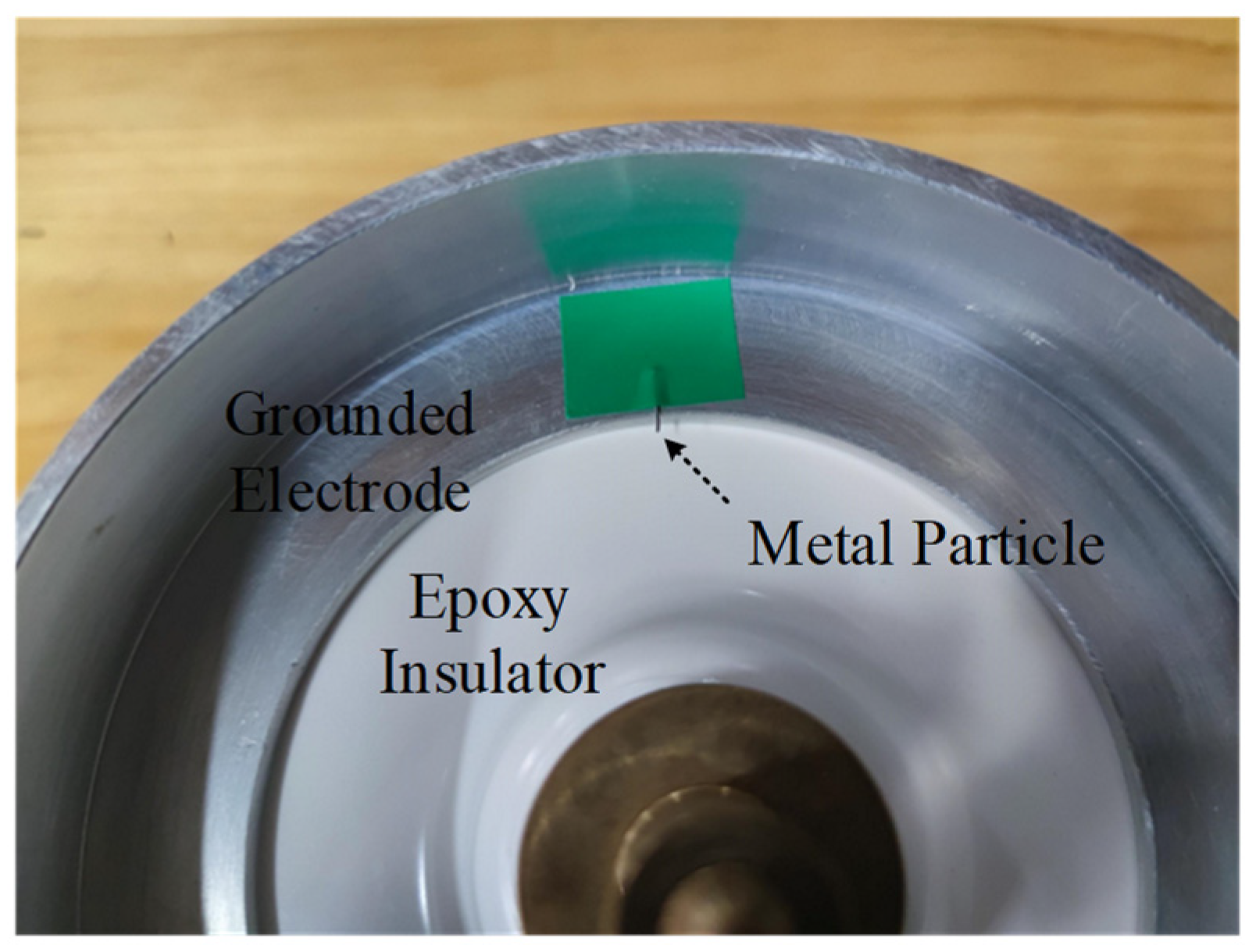
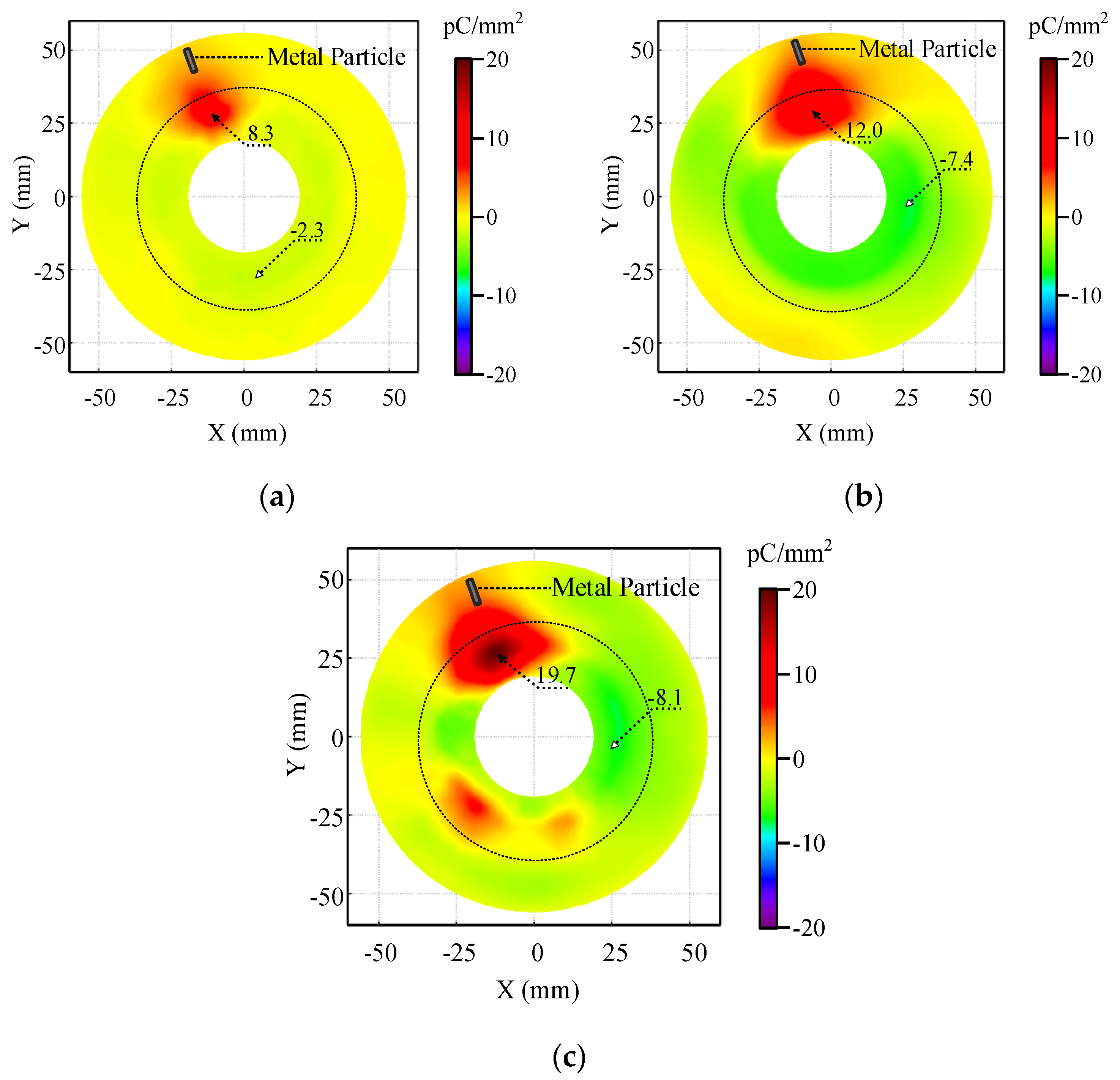
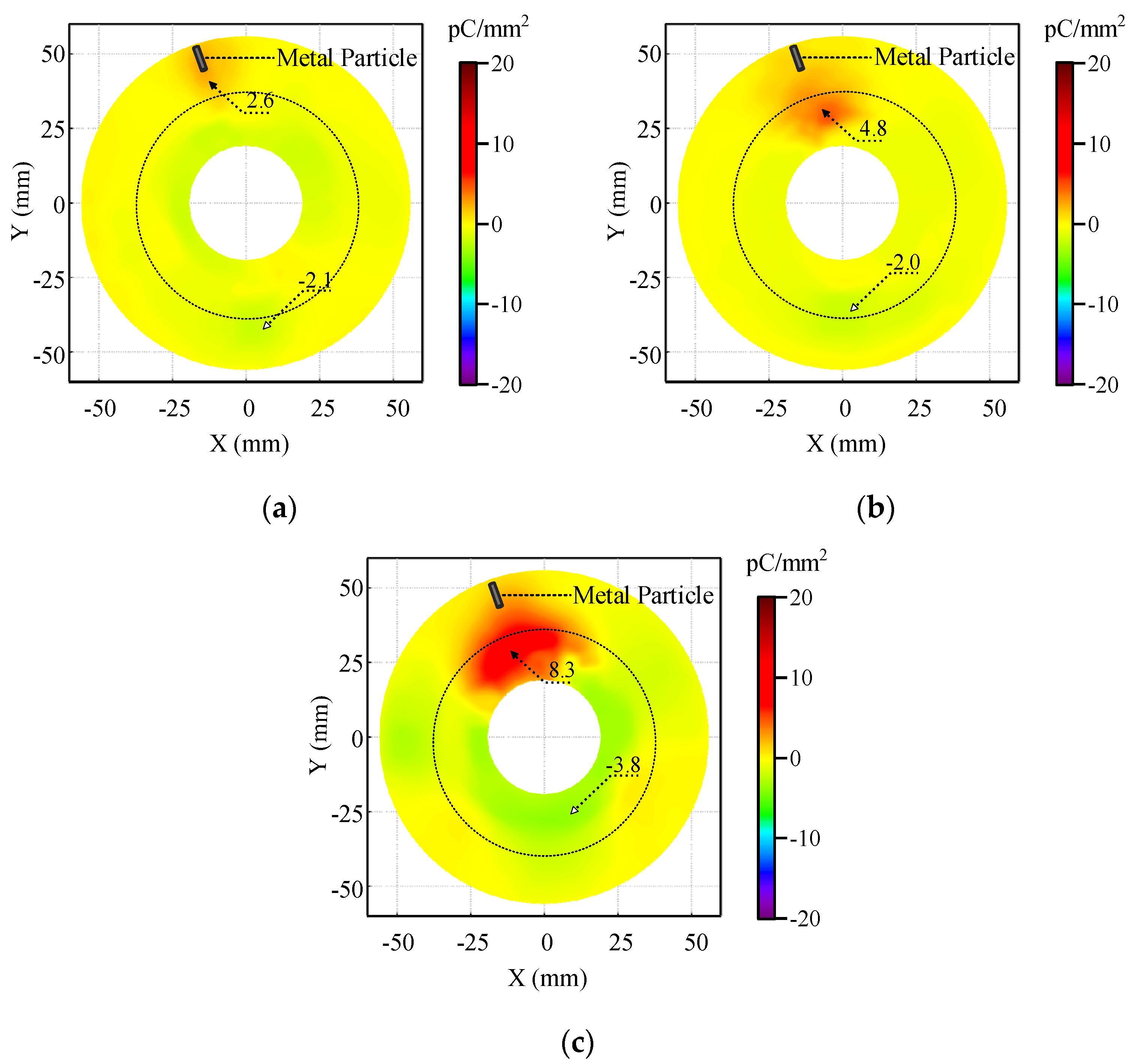
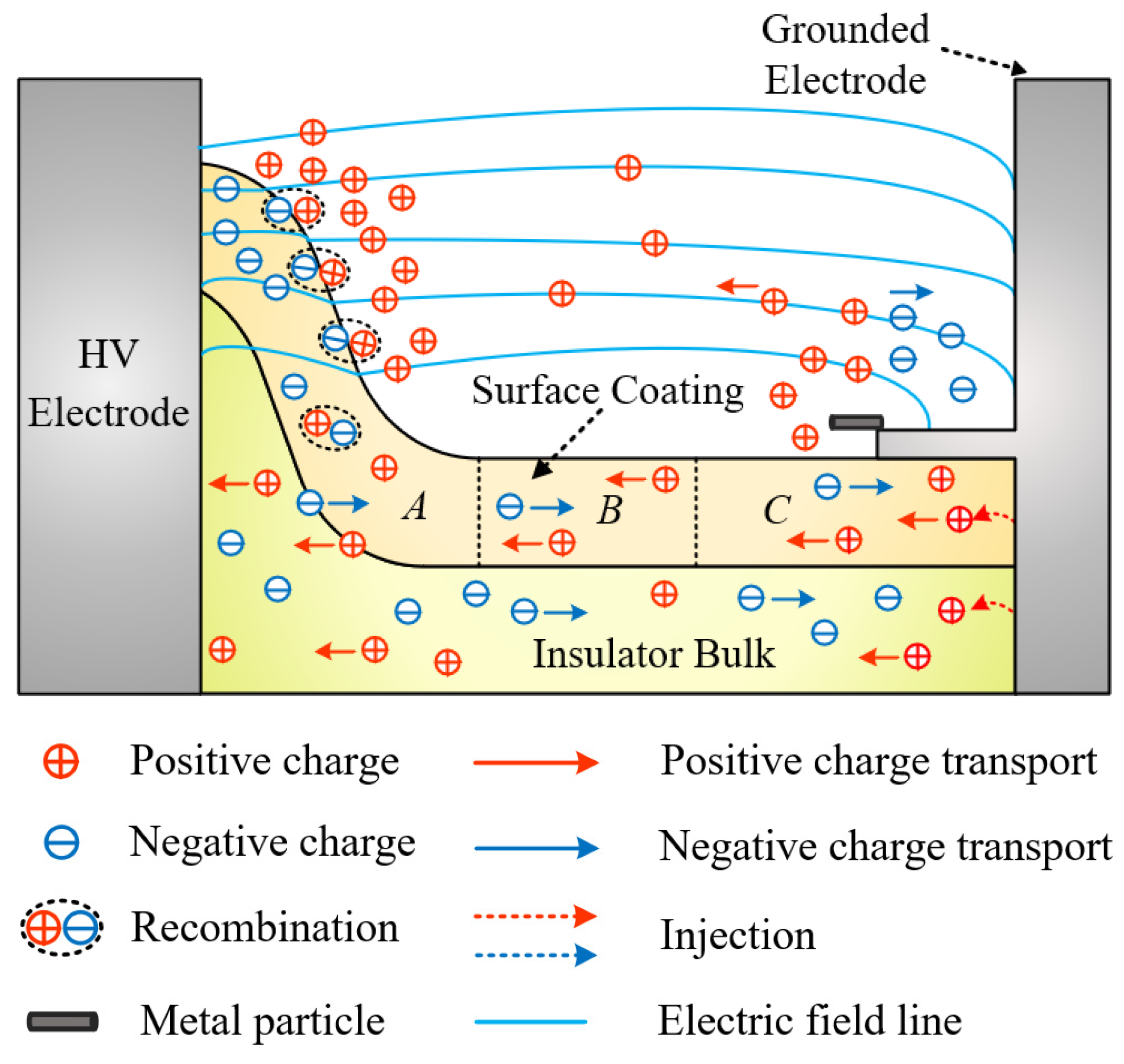
| Sample | Bulk Conductivity (S/m) | Surface Conductivity (S) |
|---|---|---|
| Reference | 2.3 × 10−15 | 1.3 × 10−18 |
| Al2O3-1 wt% | 4.04 × 10−15 | 9.35 × 10−19 |
| Al2O3-3 wt% | 4.94 × 10−15 | 1.27 × 10−19 |
| GR-1 wt% | 5.18 × 10−15 | 3.95 × 10−18 |
Publisher’s Note: MDPI stays neutral with regard to jurisdictional claims in published maps and institutional affiliations. |
© 2022 by the authors. Licensee MDPI, Basel, Switzerland. This article is an open access article distributed under the terms and conditions of the Creative Commons Attribution (CC BY) license (https://creativecommons.org/licenses/by/4.0/).
Share and Cite
Wang, W.; Gao, Y.; Zhao, H. The Effect of a Metal Particle on Surface Charge Accumulation Behavior of Epoxy Insulator with Zoning Coating. Energies 2022, 15, 4730. https://doi.org/10.3390/en15134730
Wang W, Gao Y, Zhao H. The Effect of a Metal Particle on Surface Charge Accumulation Behavior of Epoxy Insulator with Zoning Coating. Energies. 2022; 15(13):4730. https://doi.org/10.3390/en15134730
Chicago/Turabian StyleWang, Wenqu, Yu Gao, and Huicun Zhao. 2022. "The Effect of a Metal Particle on Surface Charge Accumulation Behavior of Epoxy Insulator with Zoning Coating" Energies 15, no. 13: 4730. https://doi.org/10.3390/en15134730
APA StyleWang, W., Gao, Y., & Zhao, H. (2022). The Effect of a Metal Particle on Surface Charge Accumulation Behavior of Epoxy Insulator with Zoning Coating. Energies, 15(13), 4730. https://doi.org/10.3390/en15134730






